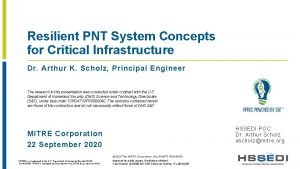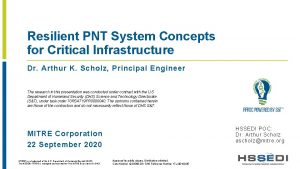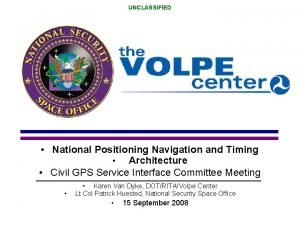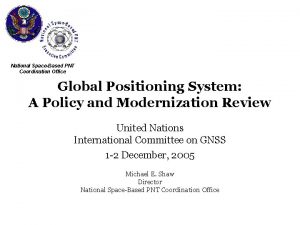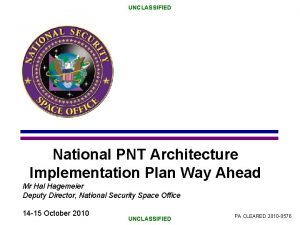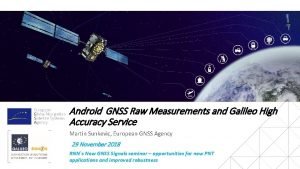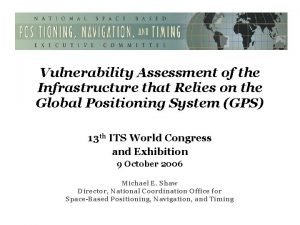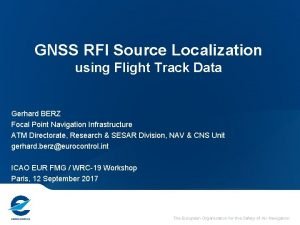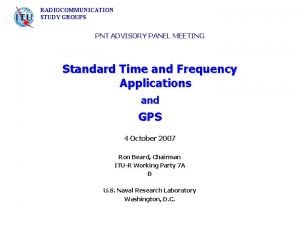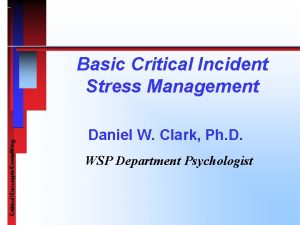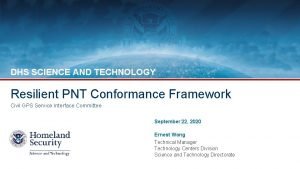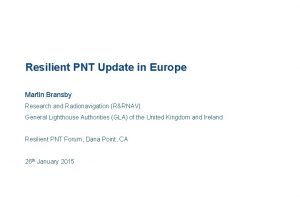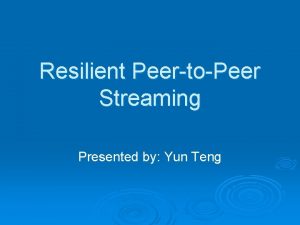Resilient PNT System Concepts for Critical Infrastructure Dr













- Slides: 13

Resilient PNT System Concepts for Critical Infrastructure Dr. Arthur K. Scholz, Principal Engineer The research in this presentation was conducted under contract with the U. S Department of Homeland Security (DHS) Science and Technology Directorate (S&T), under task order 70 RSAT 19 FR 0000040. The opinions contained herein are those of the contractors and do not necessarily reflect those of DHS S&T. HSSEDI POC: Dr. Arthur Scholz ascholz@mitre. org MITRE Corporation 22 September 2020 HSSEDI is a trademark of the U. S. Department of Homeland Security (DHS). The HSSEDI FFRDC is managed and operated by The MITRE Corporation for DHS. Approved for public release. Distribution unlimited. Case Number 19 -03383 -03 / DHS Reference Number 17 -J-00100 -05

|2| Resilient PNT – Audience: vendors and end users § Widespread use of PNT: from consumer products to highly interconnected national § § § industries, such as utilities and the financial sector. PNT Systems are a target for adversaries seeking to inflict extensive and diverse damage in the civilian sector. Natural events and weather may also limit availability for PNT Sources requiring RF input, such as the Global Positioning System (GPS) Presidential Policy Directive (PPD)-21 definition of resilience: – “The term "resilience" means the ability to prepare for and adapt to changing conditions and withstand recover rapidly from disruptions. Resilience includes the ability to withstand recover from deliberate attacks, accidents, or naturally occurring threats or incidents. ” [1] § Executive Order 13905 of Feb 12, 2020, Strengthening National Resilience Through Responsible Use of Positioning, Navigation, and Timing Services – “ ‘Responsible use of PNT services’ means the deliberate, risk-informed use of PNT services, including their acquisition, integration, and deployment, such that disruption or manipulation of PNT services minimally affects national security, the economy, public health, and the critical functions of the Federal Government. ” HSSEDI is a trademark of the U. S. Department of Homeland Security (DHS). The HSSEDI FFRDC is managed and operated by The MITRE Corporation for DHS. Approved for public release. Distribution unlimited. Case Number 19 -03383 -03 / DHS Reference Number 17 -J-00100 -05

|3| Trade-Space: Size, Weight, Power, Cost, and Resilience § SWa. P-CR: Resilience is another dimension to the usual SWa. P-C trade-space considerations. § A resilient PNT System will withstand recover from disruptions. Without resilience, a system optimized only for SWa. PC may not perform when needed. Size PNT System Design Weight Power Cost Resilience HSSEDI is a trademark of the U. S. Department of Homeland Security (DHS). The HSSEDI FFRDC is managed and operated by The MITRE Corporation for DHS. Approved for public release. Distribution unlimited. Case Number 19 -03383 -03 / DHS Reference Number 17 -J-00100 -05

|4| Resiliency versus Accuracy • Optimize PNT Systems for resilient behavior rather than a typical metric, such as accuracy • Clock 1: Not resilient to threats, better accuracy • Clock 2: Resilient to threats, accuracy is still within the application threshold First Threat Second Threat Threshold: +/- 1 µs HSSEDI is a trademark of the U. S. Department of Homeland Security (DHS). The HSSEDI FFRDC is managed and operated by The MITRE Corporation for DHS. Approved for public release. Distribution unlimited. Case Number 19 -03383 -03 / DHS Reference Number 17 -J-00100 -05

|5| Resiliency versus Accuracy • Optimize PNT Systems for resilient behavior rather than a typical metric, such as accuracy • Solution space: based on your application’s needs, choose the appropriate trade-off between allowable error and resilience (and clock choice) HSSEDI is a trademark of the U. S. Department of Homeland Security (DHS). The HSSEDI FFRDC is managed and operated by The MITRE Corporation for DHS. Approved for public release. Distribution unlimited. Case Number 19 -03383 -03 / DHS Reference Number 17 -J-00100 -05

|6| Resources for Resilience § Reference Implementation and Reference Architecture documents by HSSEDI working with DHS § Conformance Framework (CF) developed by Resilient PNT CF Working Group, bringing together manufacturers, integrators, government, and HSSEDI participation HSSEDI is a trademark of the U. S. Department of Homeland Security (DHS). The HSSEDI FFRDC is managed and operated by The MITRE Corporation for DHS. Approved for public release. Distribution unlimited. Case Number 19 -03383 -03 / DHS Reference Number 17 -J-00100 -05

|7| Conformance Framework: Resilience Levels Summary § Foundation of resilience – Protect an internal state – Better resilience withstands a threat with minimal to no degradation to performance – If the system can’t withstand a threat, it must have recovery capability Decreasing degradation to the system PVT solution performance Increasing number of sources and source type diversity Level 1 Level 2 Level 3 Level 4 Behavior Focuses on Recovery after the threat has passed, the last resort of resilience Responds to error detection by isolating compromised sources and correcting the system PVT Solution Always prevents sources from corrupting each other and protects the system PVT Solution Required source type diversity protects internal state from losing validated external input in the presence of one threat HSSEDI is a trademark of the U. S. Department of Homeland Security (DHS). The HSSEDI FFRDC is managed and operated by The MITRE Corporation for DHS. Approved for public release. Distribution unlimited. Case Number 19 -03383 -03 / DHS Reference Number 17 -J-00100 -05 Requirements from each level build on each other

|8| PNT Sources and PNT Systems PNT System § PNT Source: A PNT System component that produces a Source PNT Solution. PNT Source – Examples: oscillators and GNSS receivers § PNT System: The components, processes, and Source PNT Solution Other Components System PNT Solution parameters that collectively produce the System PNT Solution for the user. § PNT Solution: The measurements or full solutions provided by a PNT System or PNT Source. § Resilient design includes: – Selecting appropriate PNT Sources and managing them in a resilient way – Implementing resilient system architectures for PNT Systems that include resilient processes HSSEDI is a trademark of the U. S. Department of Homeland Security (DHS). The HSSEDI FFRDC is managed and operated by The MITRE Corporation for DHS. Approved for public release. Distribution unlimited. Case Number 19 -03383 -03 / DHS Reference Number 17 -J-00100 -05

|9| Concepts for Resilient PNT Design: PNT Sources § Choose PNT Sources appropriate for the Approved for public release. Distribution unlimited. Case Number 19 -03383 -03 / DHS Reference Number 17 -J-00100 -05 m er r t-t ro or er t sh an pu er e in gh ll m al hi a rn s sm te ha ut ex s PS b e G ise eiv no rec HSSEDI is a trademark of the U. S. Department of Homeland Security (DHS). The HSSEDI FFRDC is managed and operated by The MITRE Corporation for DHS. – application – Protected internal state: PNT Sources that do not receive external input, such as oscillators – PNT Sources that receive external input are used to provide long-term stability to support the short-term stability of protected internal PNT Sources – PNT Sources that receive external input are vulnerable to external threats, so they need to be monitored and used carefully to maintain resilience Lo sh cal – n ort cloc o e term k h xte s as rn tab be al ilit tte inp y r ut

| 10 | Resilient PNT Architecture PNT System Resilience Manager PNT Source Manager External Input PNT Source with Protected Internal State Other PNT Sources PNT Source PVT Solutions PVT Management and Measurements Synthesis Option B Other Options Verification History Recovery Commands Corrections PNT Solution Data and Signals Synthesis Control PNT Solution Manager Synthesis Option A PNT Solution Data, Measurements, Observables, Solution Options Final Selection of System PNT Solution HSSEDI is a trademark of the U. S. Department of Homeland Security (DHS). The HSSEDI FFRDC is managed and operated by The MITRE Corporation for DHS. • Different Approved for public release. Distribution unlimited. Case Number 19 -03383 -03 / DHS Reference Number 17 -J-00100 -05 • algorithms can be applied to the same protected internal state Internal state more protected without direct steering

| 11 | Resilient Approach to Control § Use known timing control algorithms in a resilient way – (A) Near term: minor modifications to the execution of control algorithms in existing PNT Systems – (B) Middle term: Adding functions to existing control algorithms to increase resilience – There typically will be a trade-off between standard performance metrics and resilience. However, most PNT Systems have better performance than users need (orders of magnitude), so this tradeoff is acceptable to gain resilience § Design and implement resilient control algorithms – (C) Long term: PNT System architectures and control processes that are designed to be resilient from the ground up. Ensure the system meets both resilience and performance requirements. (C) (B) Resilience (A) Effort – Time/Cost HSSEDI is a trademark of the U. S. Department of Homeland Security (DHS). The HSSEDI FFRDC is managed and operated by The MITRE Corporation for DHS. Approved for public release. Distribution unlimited. Case Number 19 -03383 -03 / DHS Reference Number 17 -J-00100 -05

| 12 | Applying Resilience to Timing Control – Long Term § Maintain a protected internal state Isolate – Ex: a local clock/oscillator § The more isolated the internal state is § Isolate external inputs as well HSSEDI is a trademark of the U. S. Department of Homeland Security (DHS). The HSSEDI FFRDC is managed and operated by The MITRE Corporation for DHS. Approved for public release. Distribution unlimited. Case Number 19 -03383 -03 / DHS Reference Number 17 -J-00100 -05 Synthesizer Time Solution rollback to a good state) ut § More control over system output (Ex: facilitates np to the internal state using a synthesizer l. I – Isolate the internal state all the time for the most secure resilience § Resilient timing control algorithms apply corrections a rn te Ex from the rest of the system, the more protected it is from corrupted external input Internal State

| 13 | Summary • Resilience should be considered part of the design space • Not all systems require the highest level of resilience • There may be tradeoffs between performance, cost, and resilience • Use untrusted external sources sparingly • Ideally protect an internal sensor (inertial, clocks, etc. ) • Continue development of language and tools of resilience • Allows end users to communicate needs to vendors and vendors to communicate capabilities to end users HSSEDI is a trademark of the U. S. Department of Homeland Security (DHS). The HSSEDI FFRDC is managed and operated by The MITRE Corporation for DHS. Approved for public release. Distribution unlimited. Case Number 19 -03383 -03 / DHS Reference Number 17 -J-00100 -05
